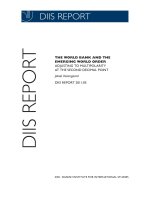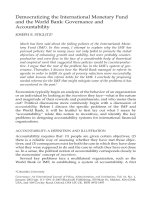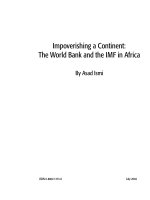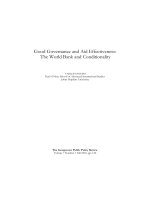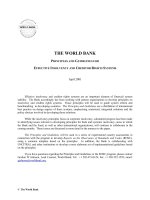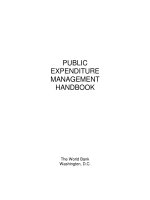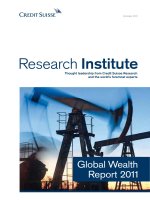THE WORLD BANK & RULE OF LAW REFORMS: GORDON BARRON doc
Bạn đang xem bản rút gọn của tài liệu. Xem và tải ngay bản đầy đủ của tài liệu tại đây (321.69 KB, 44 trang )
Working Paper Series
ISSN 1470-2320
2005
No.05-70
The World Bank & Rule of Law Reforms
Gordon Barron
Published: December 2005
Development Studies Institute
London School of Economics and Political Science
Houghton Street Tel: +44 (020) 7955 7425/6252
London Fax: +44 (020) 7955-6844
WC2A 2AE UK Email:
Web site: www.lse.ac.uk/depts/destin
Page 1 of 43
Table of Contents
Chapter 1: Introduction 2
Chapter 2 5
2.1 Law and Development Part 1: The Law and Development Movement. 5
2.2 Law and Development Part 2: The “New” Law and Development Movement 9
2.3 The Bank and the NIE. 11
2.4 Two Competing Definitions 12
The ROL under Shihata. 13
The ROL under Tung. 14
2.5 The Bank’s Definitions and Politico-Legal Theory. 14
Chapter 3 19
3.1 Definitions of the ROL and Legal and Judicial Reform 19
3.2 The Bank and its Articles 19
3.3 Reforming Laws 20
3.4 Reforming Institutions 26
Chapter 4: Conclusions 32
Bibliography 37
Websites 43
1
Page 2 of 43
Chapter 1: Introduction
The World Bank’s (“the Bank’s”) “discovery” of the Rule of Law (ROL) and ROL
reforms in the early 1990s is often held to be the result of a convergence of external
factors, not least the perceived limitations of the so-called “Washington Consensus”,
the emergence of an interest in “good governance”, and the fall of Communism in
Central and Eastern Europe.
1
But the role of the ROL in development – whether this
is perceived instrumentally or ontologically
2
- has, in fact, a much older history than
the Bank’s relatively brief experience would suggest. Theoretical interest was shown
by, notably, Max Weber, who saw legal rationality as an instrumental factor
accounting for the emergence of capitalism in Western Europe; while practical
interest was shown by the “Law and Development Movement” (LDM) of the 1960s
and 1970s, which – like the Bank is today – was dedicated to the idea that the law
could be used as a tool to promote social and economic development.
The LDM in particular has provided a wealth of ammunition for an academic
community unconvinced of the utility of the Bank’s work, and some (many of whom
took part in the original movement) have, quite rightly, expressed concerns that the
“mistakes” of the past – chief among them being that the LDM lacked a theory of law
and development - will simply be repeated by the Bank. A parallel concern has been
that the Bank’s interest in “building” the ROL coincides with a period in which the
ROL itself, as both philosophical doctrine and political theory, has been robbed of
much of its analytical content. In an age when the search for “silver bullets” in
development is arguably on the wane
3
, the ROL is put forward as the solution for an
astonishingly wide range of problems: it poses as the link between fledgling and
1
Rose (1993); Trubek (2004).
2
Daniels and Trebilcock (2004).
3
See: Kenny and Williams (2000).
2
Page 3 of 43
consolidated democracy; it promises to entrench human rights; it promises an end to
violence and corruption; and it is a sine qua non for the foundations of a market
economy.
4
But with meanings as diverse as these, one could be forgiven for thinking
that the ROL, in the end, means nothing at all.
5
The Bank’s interest in variously “building” or “promoting” the ROL comes up
against a major practical difficulty, in that, in order to construct a reform agenda –
something concrete – it has necessarily to translate the ROL as a philosophical idea
into tangible legal institutions that can be reformed.
6
This is in keeping with the body
of theory – the New Institutional Economics (NIE) - which underpins to a considerable
extent the Bank’s work in “good governance.” In practice, for the Bank: “legal and
judicial reform is a means to promote the rule of law.”
7
Tamanaha
8
has pointed out,
however, that the ROL “has always consisted more of a bundle of ideals than a specific
or necessary set of institutional arrangements.” Indeed, a distinction has been drawn in
the literature between the ROL itself, and ROL orthodoxy: the “set of ideas, activities,
and strategies geared toward bringing about the rule of law, often as a means toward
ends such as economic growth, good governance, and poverty alleviation.”
9
With this in mind, this paper sets about examining the Bank’s claims that it is
“building” or “promoting” the ROL via legal and judicial reform. It seeks to put the
Bank’s work in historical and theoretical context, with the ultimate goal of identifying
the theory or theories – so lacking in the LDM – informing the Bank’s work. The
primary argument of this paper is that the ROL is a social and political ideal more
than anything else. At the social level, it requires – at a minimum – that the law is
4
Carothers (2003).
5
Shklar (1987).
6
Belton (2003); Carothers (2003).
7
World Bank (2004a:3) emphasis added.
8
1995:476.
9
Golub (2003:7).
3
Page 4 of 43
capable of guiding one’s behaviour. The processes that allow this are extremely
complex and scarcely understood. Moreover, the evidence suggests that these
processes are either impervious to reform, or respond only extremely slowly (well
outside the timeframe of a typical Bank project). At the political level, the defining
feature of the ROL, from its origins in natural law thought through to present-day
jurisprudential writings, has been the appeal to ordinary law as a control over naked
political power, and the protection of ordinary individuals from the arbitrary acts of
government.
10
The Bank’s difficulty at this level of analysis is that reform is
ultimately dependent on the highly unsatisfactory idea of “political will.”
In order to carry out this task, the paper starts by placing the Bank’s current
work within the context of the other notable attempt to build the ROL- the failed LDM
– as well as its own work in governance. It then reviews the shift that has taken place
in the Bank’s definition of the ROL since the early 1990s, from a rigidly formal
conception, to an ambiguously substantive conception. Chapter 3 then looks at the
main vehicles the Bank uses for promoting the ROL: legal and judicial reform. It
details the theoretical basis on which the Bank’s work rests and highlights the inherent
flaws in trying to build the ROL using these means, in line with the argument stated
above. Chapter 4 concludes by reflecting on the implications of the preceding
discussion for constructing a theory of the ROL.
10
Barnett (2002).
4
Page 5 of 43
Chapter 2
2.1 Law and Development Part 1: The Law and Development Movement.
Ironically, whereas the fall of communism in the early 1990s, amongst other factors,
signalled the beginning of the Bank’s interest in the role of law in development, it was
the end of World War II and a Cold War geopolitics which started the other notable
movement in law and development (LD), the LDM.
11
The LDM was an
overwhelmingly American movement, heavily influenced by modernisation theory,
and believed that the law could speed up the social, political and economic
convergence of “The Third World” with the West. Economically, this meant a role
for the law in establishing contract and property rights, and providing market
incentives via the law’s predictability and stability functions
12
; politically, the LDM
saw a strong, liberal-democratic government emerging once a certain threshold level
of economic growth had been achieved.
13
Over the course of its brief life, the LDM
attracted the interest of the best law departments in the country
14
, drawing funds and
professional support from the likes of the Ford Foundation, the Agency for
International Development (AID), and the American Bar Association.
The LDM was primarily concerned with “the problem of ‘the gap’”
15
: the
mismatch between law “on the books” and law “in action.” It believed that “the gap”
could be narrowed by changing the rules- that new legislation could induce changes in
social behaviour. Moreover, “where it becomes apparent that immediate rule changes
will not affect social behaviour, attention shifts to the institutional changes that will be
11
Gardner (1980).
12
Burg (1977); Trubek (1972).
13
Trubek (2004).
14
Most notably Harvard, Stanford, Yale, and the University of Wisconsin.
15
Burg (1977:511).
5
Page 6 of 43
needed to guarantee that this will occur.”
16
In practice, this meant attention shifted to
a poorly educated bar and judiciary, and the LDM became a programme, first and
foremost, of legal education reform
17
, the expectation being that “once the obstacle of
a passive legal profession is removed, instrumental solutions will play themselves
out.”
18
Training programmes were established throughout Latin America, Asia and
Africa in the hope that lawyers and judges could be trained to appreciate the
developmental role of the law and, in a sense, become “social engineers.”
19
The theory had an appealing logic, but it lacked an explicit, social-scientific
rigour.
20
Merryman
21
saw this as a problem of the “intellectual style” of US legal
scholarship, which he saw as more professional and practical, than theoretical.
Consequently, the LDM lacked the social sciences’ concern with theory and theory-
building. What it did have, however, was a “tacit set of assumptions”
22
which guided
LDM action. Trubek and Galanter
23
(TG) – whose hugely influential 1974 article
marked the beginning of the end of the movement - labelled these assumptions
“liberal legalism”, and set the paradigm out in the form of seven propositions:
1) “‘[t]he state is the primary locus of supranational control in society’; 2) ‘the
state exercises its control over the individual through law – bodies of rules
that are addressed universally to all individuals similarly situated’; 3) ‘rules
are consciously designed to achieve social purposes or effectuate basic social
principles’, and these rules are made through a ‘pluralist process’; 4) these
rules are ‘enforced equally for all citizens, and in a fashion that achieves the
purposes for which they were consciously designed’; 5) ‘the courts have the
principal responsibility for defining the effect of legal rules’; 6) the outcome
of adjudication by the courts is determined not by the policies underlying
those rules or by extraneous considerations, but by an ‘autonomous body of
learning’; and 7) ‘the behaviour of social actors tends to conform to the
rules.’”
24
16
Trubek and Galanter (1974:1079) emphasis in original.
17
Faundez (1997); Gardner (1980); Tamanaha (1995); Trubek (2004); and Trubek and Galanter (1974).
18
Burg (1977:512).
19
Messick (1999:12).
20
Friedman (1969a); Merryman (1977).
21
1977:477.
22
Trubek and Galater (1974:1070).
23
Ibid.
24
Trubek and Galanter (1974:1071-1072), in Berg (1977:513).
6
Page 7 of 43
For TG, a major failing of this liberal legalist model was its “ethnocentricity” and
“naivety.”
25
When measured against the reality of developing countries, it did not
correspond at all well: where the model assumed social and political pluralism, the
reality in poor countries was often “social stratification and class cleavage juxtaposed
with authoritarian or totalitarian political systems”
26
; where the state was supposed to
be “the primary locus of social control”
27
, it was in fact frequently overpowered by
the strength of “tribe, clan, and local community.”
28
Other problems stemmed from
the fact that there was no internalisation of the laws by the citizens of the countries in
which reform was taking place, and thus no real observance of it
29
; and instead of a
central role in social control for an independent judiciary free from tribal, religious,
political, or class interests, the courts were more often than not “neither very
independent nor very important.”
30
What TG called “the most serious challenge”
31
,
however, was the recognition that the law could be used in an anti-developmental
way, and that the best lawyers, newly trained by LDM programmes, could be used by
elites to resist change and consolidate their privileged positions.
32
Thus, while the
LDM had foreseen the primary agent in change as a “strong, relatively centralized
state”
33
, it had been unable to anticipate that “when the state is captured by
authoritarian groups, law seen in primarily instrumental terms cannot serve as a
25
Trubek and Galanter 1080.
26
Ibid.
27
Ibid.
28
Ibid.
29
Ibid at 1080-1081.
30
Ibid.
31
Ibid at 1083.
32
Ibid.
33
Trubek (1972); Trubek and Galanter (1974:1079).
7
Page 8 of 43
restraint. Lacking its own internal values or goals, law will become an instrument of
those who control and set the goals of the state.”
34
Faundez
35
has recently pointed out that while there are obvious similarities
between the Bank’s conception of a fair legal system in its current ROL work, and
liberal legalism, the current context is fundamentally different. Under the Bank’s
approach the state is no longer “the primary locus of supranational control”, but
limited to complementing the market in a very restricted way. The chance of the
law’s capture by elites, he says – TG’s “most serious challenge” - is thus considerably
reduced.
36
Despite the change in the role of the state, however, other issues raised by
LDM scholars still appear to linger: the issue of foreign lawyers obtaining a sufficient
knowledge of local culture, society, and the legal system to be able to construct the
right kind of programs, and not simply resorting to transplanting laws and legal
institutions from one country into another
37
; the issue of traditional dispute settlement
mechanisms
38
and attempting to formalise and professionalise what should perhaps be
left alone or even de-formalised
39
; the issue of hostility and resistance to foreign legal
assistance
40
; and the issue of the cost of program failure for the foreign legal expert,
separated as he is by “geographic, political and cultural distance”, being far lower
than those who actually live in the target nation.
41
34
Tamanaha (1995:474).
35
1997.
36
Ibid.
37
Merryman (1977).
38
Beckstrom (1973); Trubek and Galanter (1974).
39
Trubek and Galanter (1974:1078); More recently: Kennedy (2003); Upham (2002).
40
Gardner (1980).
41
Merryman (1977:480).
8
Page 9 of 43
2.2 Law and Development Part 2: The “New” Law and Development
Movement.
Despite these issues which, sparked by TG’s article, led to “The Decade of
Disillusion”
42
with law and development (LD), the 1990s emerged as “The Decade of
(re)-Discovery.”
43
Development practitioners from the EU, DFID, EBRD, UNDP,
various Western governments, and the African, Asian, and Inter-American
Development Banks identified in the 1990s two important roles for the ROL
44
: on the
one hand, the ROL could be used to ensure the proper functioning of a market
economy, by providing protection for property rights; third party enforcement of
contracts; and a stable, crime-free investment environment. On the other, the ROL
could be used to help the emergence of democracy, good governance, and the
protection of basic human rights.
45
Although the LDM had been no stranger to the
“promotion of the rule of law”
46
(the implication was that all 7 elements of TG’s
paradigm of liberal legalism needed to be present in order for there to be a ROL
system)
47
, the “new” law and development movement has increased the ROL rhetoric
and explicitly embraced the ROL as a goal of development policy. According to
Trubek
48
, the Bank alone has spent $2.9 billion dollars on some 330 projects in its
pursuit of the ROL since 1990.
The clearest statement of the Bank’s role in this “new” LDM is to be found in
its annual review of legal and judicial reform.
49
The 2004 edition lists both the factors
contributing to its interest in the law, and what it hopes to achieve via the law
50
:
42
McAuslan (2004:10).
43
Ibid.
44
Carothers (1998); Trubek (2004).
45
Rose (1998); Trubek (2004).
46
Gardner (1980:8).
47
Tamanaha (1995).
48
2004.
49
World Bank (2004a).
50
Ibid at 1-2.
9
Page 10 of 43
“The dramatic political and economic transformation in Eastern
Europe and the former Soviet Union…naturally mandated institutional
reforms and required creating legal and institutional infrastructure to
support, implement, and enforce the new legal system.”
“The Asian financial crisis…vividly illustrated that economic growth
without the firm foundation of effective laws and legal institutions was
vulnerable and unsustainable.”
“Development experience…showed that the rule of law promotes
effective and sustainable economic development and good
governance. Lack of the rule of law significantly hinders economic
growth…”
“[D]omestic and foreign private investment…could not be reached
without modifying or overhauling the legal and institutional
framework and firmly establishing the rule of law to create the
necessary climate of stability and predictability.”
51
“[E]nvironmentally sustainable development mandates rigorous
regulatory regimes, clear property rights, and appropriate institutional
frameworks.”
“Discriminatory or arbitrarily enforced laws deprive individuals of
their individual and property rights, raise barriers to justice and keep
the poor poor.”
As the above list shows, the Bank speaks in terms of effective “laws”, “legal
institutions”, and “the ROL”, and it pursues these objectives through the conditions it
attaches to loans; in projects where legal and judicial reform is the sole objective; and
in other projects like public sector reform, which often have a legal component.
52
The
Bank’s claims for the law have inspired voluminous literature, both supportive and
contradictory, though a detailed review is outwith the scope of this study.
51
Ibid. emphasis in original.
52
10
Page 11 of 43
2.3 The Bank and the NIE.
While many of the above claims made on behalf of the law and the ROL may appear
more anecdotal than theoretical (e.g. reforms are “naturally mandated” as a result of
“development experience”), that is not to say the Bank approaches its work entirely
on working assumptions. Underpinning the Bank’s interest in the ROL is, in fact - to
a considerable extent - the body of economic theory known as the New Institutional
Economics (NIE), the great contribution of which has been to identify the institutional
foundations of the neo-classical model of economics. “Institutions”, according to
North
53
, “are the humanly devised constraints that structure political, economic and
social interaction. They consist of both informal constraints (sanctions, taboos,
customs, traditions, and codes of conduct), and formal rules (constitutions, laws,
property rights).” Property rights in particular play a central role in the NIE analysis,
and the absence of well-defined and effectively enforced property rights has been
identified as a major factor contributing to high transaction costs and poor economic
performance through time.
54
The state plays a crucial role in both the NIE analysis
and the Bank’s good governance agenda, in that (as Faundez
55
alluded to earlier) it
both specifies and enforces the formal “rules of the game”
56
, providing the legal
infrastructure and other institutions necessary for the protection of property rights.
The fundamental problem with property rights, however – referred to in the
political science literature as the “commitment problem” – is that any state or leader
powerful enough to grant them, is also powerful enough to abrogate them for his own
benefit.
57
In order to truly secure property rights and encourage investment, there
53
1991:97.
54
North and Thomas (1973).
55
1997.
56
North (1990:3).
57
Haber et al. (2003).
11
Page 12 of 43
have to be mechanisms in place to allow that rights in property will be respected
regardless of the proclivities of individual leaders or ruling groups. Government, in
other words, has to restrain itself – or be made to restrain itself - from acting in its
own short-term interest. One possible – though ultimately unsatisfactory - solution to
the commitment problem is what Mancur Olson has called “stationary banditry.”
58
For the NIE, however, “while economic growth can occur in the short run with
autocratic regimes, long-run economic growth entails the development of the rule of
law and the protection of civil and political freedoms.”
59
Thus, the NIE provides a
valuable link for the Bank, in that it explicitly identifies the ROL as a factor
contributing to economic growth, and highlights the importance of the positive law
and legal institutions for protecting property rights, enforcing contracts, and otherwise
making up several of the constituent parts of the ROL.
2.4 Two Competing Definitions.
Having identified (in a necessarily brief manner) the importance the of ROL to the
Bank, the question then becomes: how does a country go about acquiring it? Clearly,
before the ROL can be “built” or “promoted”, it has to be defined. Definitions of the
ROL are important because they specify – or should specify - the end-goal of the
Bank’s efforts in legal and judicial reform. The term, however - like other popular
terms in the development discourse, such as “globalisation” and “the Washington
Consensus” - is a slippery one, and tends to mean different things to different people.
For USAID, for example, the ROL means “equal treatment of all people before the
law”; “fairness”; “human rights”; “the protection of citizens against the arbitrary use
58
1993. See for discussion: Haber et al. (2003); and Przeworski (2004).
59
North (1995:25).
12
Page 13 of 43
of state authority”; and “judicial independence.”
60
The UNDP, on the other hand,
stresses in its definition that “legal frameworks should be fair and enforced
impartially”; that there should be “equal protection (of human as well as property and
other economic rights)”; and that there should be “clear communication of the rules”
and “punishment under the law.”
61
The following discussion will identify how the
Bank defines “the ROL”, and locate these definitions within existing jurisprudential
and political debate.
The ROL under Shihata.
The World Bank’s working definition of the ROL has tended to reflect the particular
views of its reigning General Counsel. Ibrahim Shihata, the Bank’s Counsel from
1983-98, for example, defined the ROL as “a system, based on abstract rules which
are actually applied and on functioning institutions which ensure the appropriate
application of such rules.”
62
More specifically, the ROL required that:
a) there is a set of rules which are known in advance; b) such rules are actually in
force; c) mechanisms exist to ensure the proper application of the rules and to allow
for departure from them as needed according to established procedures; d) conflicts
in the application of the rules can be resolved through binding decisions of an
independent judicial or arbitral body; and e) there are known procedures for
amending the rules when they no longer serve their purpose.
63
This was the definition of the ROL which coincided with the Bank’s “discovery” of
the law in the early 1990s, and lasted for the duration of Shihata’s term as General
Counsel.
60
61
/>62
Shihata (1991:85) emphasis in original.
63
Ibid.
13
Page 14 of 43
The ROL under Tung.
The Bank’s position appears to have changed, however, in recent years, and the ROL
was defined in a different way by Shihata’s successor as General Counsel, Ko-Yung
Tung, in a speech he gave in 2002.
64
The definition of the ROL put forward in that
speech has been incorporated into the Bank’s most recent publications on legal and
judicial reform.
65
It asserts that the ROL prevails where:
(1) the government itself is bound by the law; (2) every person in society is
treated equally under the law; (3) the human dignity of each individual is
recognized and protected by law; and (4) justice is accessible to all. The rule
of law requires transparent legislation, fair laws, predictable enforcement, and
accountable governments to maintain order, promote private sector growth,
fight poverty, and have legitimacy.
66
2.5 The Bank’s Definitions and Politico-Legal Theory.
What are the implications of these two separate definitions? A crucial distinction
made by legal theorists in discussing the ROL is between formal and substantive
definitions. Formal definitions gauge the existence of the ROL according to whether
or not certain objectively verifiable criteria are present in the legal system (e.g.
whether or not laws are prospective; whether or not some means of judicial review
exists), but demand nothing of the actual content of the law.
67
Substantive definitions,
on the other hand – as well as insisting on the formal criteria - ask questions of the
actual laws themselves.
68
Laws are held to conform to the ROL only insofar as they
meet certain subjective criteria as regards the morality of the legal system, such as
64
World Bank (2002a).
65
World Bank (2002b);(2003);(2004a).
66
World Bank (2004a:2-3).
67
e.g. Craig (1997); Raz (1977, 1979).
68
e.g. Dworkin (1986).
14
Page 15 of 43
whether the laws are “good” laws or “just” laws.
69
Legal scholars tend to prefer
formal definitions of the ROL because they allow for an element of consensus- the
formal criteria are either there, or are not. Substantive conceptions, in contrast, are a
battleground for competing notions of justice and differing moral visions. “If the rule
of law is the rule of good law”, says Joseph Raz
70
, “then to explain its nature is to
propound a complete social philosophy. But if so the term lacks any useful function.”
This distinction between formal and substantive definitions of the ROL is crucial to
understanding the Bank’s work in legal and judicial reform, not least because
substantive conceptions – incorporating various degrees of civil and political rights –
are incredibly difficult for the Bank to work with, given the legal constraints of its
charter. Thus, the Bank has a vested interest in promoting as formal and technocratic
a version of the ROL as possible.
71
Although the language has changed in recent years, at the heart of the Bank’s
ROL remains a stark formalism. Shihata’s 1991 definition reflects this most clearly,
in that it says nothing explicit about the substance of the rules, only the procedures
through which rules are formulated and applied. The rationale, in keeping with the
Bank’s charter, is purely economic: to create a stable, predictable legal environment
in which economic actors can come together and transact, free from the arbitrary
interference of government. Tung’s definition, on the other hand – given that it refers
to issues of equality; human dignity; and “accountable governments to maintain order,
promote private sector growth, fight poverty, and have legitimacy” - seems to have
included more of a substantive criteria. However, this is not necessarily so (although
there is ample scope for debate). For example, when A.V. Dicey
72
first wrote of
69
Craig (1997).
70
1977:195-196.
71
Belton (2005:31); Tshuma (1999:83).
72
1960:193.
15
Page 16 of 43
equality before the law, he was not referring to a substantive equality whereby all
members of a society would have equal legal rights and duties, but to a principle by
which everybody – government officials as well as ordinary citizens – would be
accountable for their actions in the ordinary courts.
73
Thus, Craig
74
has written
(echoing Geoffrey Marshall
75
), “Dicey’s formulation is concerned primarily with
formal access to the courts, not with the nature of the rules which individuals will find
when they get there.”
76
Similarly, “human dignity” is also open to a formal
interpretation: both Friedrich Hayek
77
and Raz
78
explicitly tied adherence to a formal
conception of the ROL into ideas of individual autonomy and human dignity.
79
A far
more controversial part of Tung’s definition than his ideas of equality and human
dignity, however, would appear to be his linking of the ROL with the goals of private
sector growth and poverty reduction. This seems to move the ROL beyond the
guarantee of certain negative freedoms, and into the realms of promoting positive
rights. While it might seem that this is not particularly controversial territory for the
Bank– generating economic growth and fighting poverty are, after all, its stated
objectives – the legal community has in the past responded with scepticism to such
expanded conceptions, both because of the perception that they represent a muddying
of the theoretical waters – the ROL becomes all things “good” - and because they put
a financial cost on the ROL: the cost of fighting poverty.
80
Barber
81
has made a
73
Hood Phillips and Jackson (2000); and Jennings (1959).
74
1997:472.
75
1971.
76
Indeed, if that is the case, Tung’s fourth element – that “access is accessible to all” - becomes more
or less redundant.
77
1986.
78
1977;1979.
79
Respecting human dignity was not for Hayek and Raz a matter of specifically legislating in
accordance with that goal, but rather a function of allowing individuals to plan their future with
certainty- to know in advance the consequences to be expected of their actions. See: Raz (1977:204).
80
See: International Commission of Jurists (1959:3) for the most well-known and controversial
example of a substantive ROL, incorporating the “social, economic, educational, and cultural
conditions under which man’s legitimate aspirations and dignity may be realized.”
16
Page 17 of 43
strong case, however, that even the most formal of ROL conceptions presupposes a
certain basic level of social and material well-being. Access to the courts, for
example, requires an education (so that rights are known); money (so that the costs of
litigating can be afforded); and the absence of gross imbalances of power (so that a
person is not intimidated into avoiding recourse to the courts). There is a fine line,
however, between endorsing those rights which flow naturally from a formal ROL,
and those which drift into the realms of a substantive ROL.
Where does this leave the Bank in terms of defining the end-goal of legal and
judicial reform? On the one hand, substantive definitions allow the Bank to move
past morally neutral formal conceptions which allow that even “a non-democratic
legal system, based on the denial of human rights, on extensive poverty, on racial
segregation, sexual inequalities, and religious persecution may, in principle, conform
to the requirements of the rule of law.”
82
On the other, however, substantive
conceptions are extremely political and (especially when the substantive space is
filled with a particular vision of a “developed” society – 1) a market economy; 2) if
not democracy, then the values of democracy in the form of good governance; and 3)
human rights) open the door once again to the charges of “ethnocentricity” and
“naivety” that were levelled at the LDM.
83
Legal positivists seek to keep issues of
law and issues of morality separate. Thus, while Tung’s definition may remain
formal, it is ambiguously so, and the danger for the Bank, from a legal positivist
perspective, is that it finds itself “getting mired in never-ending debates about the
superiority of the various political theories all contending for the throne of justice”
84
,
81
2004.
82
Raz (1977:196).
83
See also Finnis (1980:272); and Peerenboom (1999:318).
84
Peerenboom (2004:19).
17
Page 18 of 43
rather than striving for the simple goals of stability and predictability in market
exchange.
18
Page 19 of 43
Chapter 3
3.1 Definitions of the ROL and Legal and Judicial Reform.
Whatever shift may have taken place since the early 1990s in the way the Bank
defines the ROL, its actual work in ROL reform – what was referred to in the
introduction as “ROL orthodoxy” – has actually changed very little. The Bank’s
internal think-tank (Legal Institutions of the Market Economy) - under the heading
“Building the Rule of Law”
85
- enumerates the various reforms deemed necessary for
actuating the ROL. These are: “reforming laws” (i.e. drafting substantive laws, for
simplicity often categorised under five main headings: property; contract; company;
bankruptcy; and competition); and “reforming institutions” (“including courts,
legislative bodies, property registries, ombudsmen, law schools and judicial training
centers, bar associations, and enforcement agencies.”)
86
These, say the Bank, are the
means by which the ROL can be “built” or “promoted.” It will have been noted that
this closely parallels Shihata’s original conception of the ROL as “a system, based on
abstract rules…and on functioning institutions.”
87
The following section of the paper
will examine this claim by the Bank- that concrete reforms can contribute to the goal
of actuating the ROL.
3.2 The Bank and its Articles.
Before doing that, however, it is as well to point out explicitly what the Bank is – and
is not – capable of achieving in terms of building the ROL. This is not so much a
question of ambition, as a question of the limitations imposed by its charter. Article
85
86
87
See note 61 above.
19
Page 20 of 43
IV, section 10 of the Bank’s Articles of Agreement notes: “The Bank and its officers
shall not interfere in the political affairs of any member; nor shall they be influenced
in their decisions by the political character of the member or members concerned.”
What this means in practice, is that the Bank has had to avoid “revisions of criminal
codes, training of police or judges involved solely in criminal matters, or management
of penitentiary institutions”,
88
and generally any other area deemed too political by its
General Counsel (such as constitutional law). Thus a central tension resides at the
heart of the Bank’s ROL work: the desire to “build” the ROL but only able to focus its
reform efforts on the institutions which significantly affect the economic performance
of a country. More will be said about the restriction of the Bank’s charter in Chapter
4, when its implications for constructing a “theory” of law and development are
considered.
3.3 Reforming Laws.
How does the Bank’s work in drafting economic laws contribute to “building” the
ROL? Joseph Raz
89
provides probably the clearest and most influential discussion of
a formal ROL, and suggests that “the basic intuition from which the doctrine of the
rule of law derives”, is that “the law must be capable of guiding the behaviour of its
subjects.” From this basic idea, he elicits a list of principles which should be able to
be applied to any law in order that it conform to the ROL: “all laws should be
prospective, open and clear; laws should be relatively stable; and the making of
particular laws (particular legal orders) should be guided by open, stable, clear and
88
World Bank (1995:14).
89
1977:198.
20
Page 21 of 43
general rules.”
90
These principles, says Raz, are the minimum requirement to allow
people “to choose styles and forms of life, to fix long-term goals and effectively direct
one’s life towards them.”
91
The Bank’s drafting of substantive laws is therefore
necessary for the ROL in a very obvious way: if there are no laws, by definition a
person cannot allow himself to be guided by them.
92
Similarly, existing means of
structuring behaviour – perhaps based on trust, social networks or customs, and not
codified - may not meet the ROL criteria.
In fact, the Bank is in a very general sense in good theoretical company in
relation to its work in legal reform: the idea that a body of law can be uprooted from
one country, transported to another, and perform substantially the same function, has
– if not theoretical consensus – strong empirical support. Virtually every legal system
can trace its origins back to either the English common law, the French Napoleonic
Code, the German Bürgerliches Gesetzbuch, or the Scandinavian civil law (or a
combination thereof). This is primarily the result of three major waves of “legal
transplantation”: “the period of imperialism (1890–1914)”, during which laws were
spread by colonisers to the four corners of the world; the period after World War II,
when laws were borrowed from the former colonisers by the formerly colonised; and,
lastly, the period following the collapse of communism in Central and Eastern
Europe.
93
Given this history of legal borrowing – which Upham
94
prefers to call
“transnational legal learning”, given it is how legal systems have avoided the long
(some would say unnecessary) process of developing laws internally - the issue is not
so much whether or not laws have been borrowed, as whether or not, when borrowed,
they have been able to substantially guide individuals’ behaviour. In this respect, the
90
Ibid at 198-201.
91
Ibid at 203.
92
World Bank (2002b).
93
Berkowitz et al. (2003:165).
94
2002:33; See also David (1963) for the classic discussion.
21
Page 22 of 43
field of comparative law has been perennially concerned with identifying the reasons
why transplants seem to “take root” in some countries, but not in others.
The underlying logic guiding the Bank’s work in legal reform seemed in the
early 1990s to proceed on the assumption that if the full panoply of economic laws
was legislated for, demand would rise up to meet it.
95
This idea had much in common
with Alan Watson’s
96
theory of legal transplants, which controversially suggested that
the reception of Roman law by the countries of Western Europe had demonstrated that
transplantation is a more-or-less technical exercise, and that “legal rules may be very
successfully borrowed where the relevant social, economic, geographical and political
circumstances of the recipient are very different from those of the donor system.”
“How otherwise”, he asked, “could one explain the use made of Roman law by fifth-
century Germanic tribes, the acceptance of so much Roman law dating from different
periods and different political circumstance in the Middle Ages and later by so many
diverse States in Western Europe, in monarchies, oligarchies and republics alike?”
97
Watson was controversial because he was going against a line of thought going back
to Montesquieu
98
, who saw laws as being unique to a country’s geography, politics,
culture, religion and even climate, so as to render it “very unlikely for those of one
nation to be proper for another.”
99
More recently, the Bank seems to have reached a
middle-ground between these two positions, and its Legal Institutions of the Market
Economy website advises that “Legal transplants have ‘taken’ much less often than
one might expect. The reason may be an over-emphasis on the law’s content at the
expense of sensitivity to local context in the adaptation and implementation
95
Hendley (1999).
96
1974; 1976:80-81.
97
Ibid at 81.
98
1977:105.
99
More recently, Legrand (2001).
22
Page 23 of 43
process.”
100
In other words, legal transplantation is neither a wholly technical
process, nor wholly impossible, but achievable so long as due regard is paid to the
process of implementation and the conditions of the “receiving” country.
The Bank picked up on the idea of “legal culture”
101
in the mid-1990s as
attempts to import masses of European and American corporate, bankruptcy, and
property laws into central and eastern Europe (what Berkowitz et al
102
have called a
“legislative tornado”) produced only “mixed”
103
results. This was not a problem
faced only by the Bank, but a problem faced by all donors. “Legal culture” thus
emerged as a convenient term for explaining away the failure of legal transplants,
while still allowing donors to claim the laws, in and of themselves, were “good” laws.
The problem in Russia, for example, was not the American and European laws being
imported: the problem was ordinary Russians and a rule-sceptical Russian legal
culture, the product of years of Soviet-era neglect and political abuse of the legal
system.
104
One Bank discussion paper from the late 1990s thus concluded, “We
generally do not provide specific recommendations on the legal system, other than
stressing the need to develop a legal culture in Russia that is consistent with the
operation of a market economy.”
105
The term “legal culture” may convey the point as to why some laws “take”
and others do not, but its ability to inform actual, concrete reform projects is
extremely limited. At the same time as legal culture has been singled out by the Bank
as a crucial variable for the success of legal transplants, debates have carried on over
100
101
According to Friedman (1977:76), legal culture is the “attitudes, values, and opinions held in
society, with regard to law, the legal system, and its various parts. So defined, it is the legal culture
which determines when, why and where people use law, legal institutions or legal processes; and when
they use other institutions, or do nothing.”
102
2001:3.
103
Ibid; McAuslan (2004:64); Sachs (1998); see also: Ajani (1995); and Waelde and Gunderson
(1994).
104
See: Hendley (1999); Sajo (1999).
105
World Bank (1998:111).
23
Page 24 of 43
the term itself: how to define it, how to measure it, and how to establish its causal
effects.
106
Roger Cotterrell
107
, for example, has remarked that the term serves “more
of an artistic than a scientific function”, and that “it may, indeed, be impossible to
develop a concept of legal culture with sufficient analytical precision to give it
substantial utility as a component in legal theory and, especially, to allow it to indicate
a significant explanatory variable in empirical research in sociology of law.”
108
Deciphering how the Bank views legal culture as part of a process of concrete
reforms – besides broad statements to the effect that “it’s important” – is actually
quite difficult. On the one hand, it claims that “knowledge of the legal culture is key
to adopting culturally adequate reforms.”
109
Yet it also claims that “changing the
legal culture is one of the key elements of the reform process.”
110
Thus two separate
issues are highlighted, each of which has different implications for the Bank’s work.
The first talks of acquiring knowledge of legal culture. In theory, this is the kind of
information that is – or should be – collected as part of one of the Bank’s Legal and
Judicial Sector Assessments. The second raises the idea of changing legal culture.
Whereas the former suggests adapting rules to fit local cultures, the latter suggests
adapting the culture to fit the rules. The problem with the first stance, is that despite
the Bank’s documents being littered with references to the need to “be more sensitive
to local context”
111
, attempts to understand “local context” before introducing new
laws – however common sense a notion this would seem – are in practice quite rare.
One practitioner
112
points out that these reconnaissance missions are virtually never
carried out, “either because of time constraints, shortage of resources or simply
106
107
1997:20.
108
Ibid at 14.
109
World Bank (1999:22).
110
Ibid.
111
World Bank (1995:11).
112
Faundez (2000:7).
24


